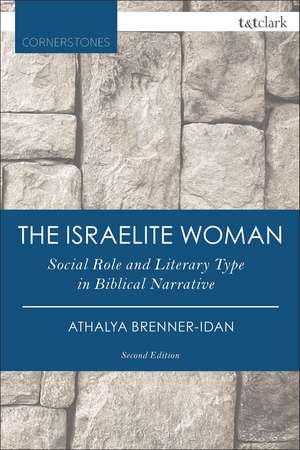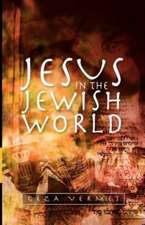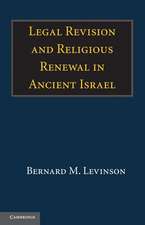The Israelite Woman: Social Role and Literary Type in Biblical Narrative
Autor Athalya Brenner-Idanen Limba Engleză Paperback – 19 noi 2014
Preț: 158.64 lei
Preț vechi: 183.93 lei
-14% Nou
Puncte Express: 238
Preț estimativ în valută:
30.36€ • 32.46$ • 25.31£
30.36€ • 32.46$ • 25.31£
Carte tipărită la comandă
Livrare economică 17 aprilie-01 mai
Preluare comenzi: 021 569.72.76
Specificații
ISBN-13: 9780567657732
ISBN-10: 0567657736
Pagini: 168
Dimensiuni: 156 x 234 x 15 mm
Greutate: 0.3 kg
Ediția:Revised
Editura: Bloomsbury Publishing
Colecția T&T Clark
Locul publicării:London, United Kingdom
ISBN-10: 0567657736
Pagini: 168
Dimensiuni: 156 x 234 x 15 mm
Greutate: 0.3 kg
Ediția:Revised
Editura: Bloomsbury Publishing
Colecția T&T Clark
Locul publicării:London, United Kingdom
Caracteristici
Presents concise coverage of the main groups of women represented in the Hebrew Bible: queens, prophetesses, etc. Very tightly structured as a result
Notă biografică
Athalya Brenner-Idan is Professor Emerita of the HB\OT Chair at the Universiteit van Amsterdam, The Netherlands; and currently Professor in Biblical Studies at the Department of Hebrew Culture Studies, Tel Aviv University, Israel, and Research Associate at the Biblia Arabica Project there. In addition, she is Extraordinary Professor at the Department of OT/NT, Faculty of Theology, Stellenbosch University, South Africa. Her website is http://athalya-morah-letorah.com.
Cuprins
AbbreviationsPrefacePreface [1985]1. IntroductionPart 1: Women, Professions and Social Institutions2. Queens3. Wise Women4. Women Poets and Authors5. Prophetesses6. Magicians7. Female ProstitutionPart 2: Literary Paradigms of Female Types and Behaviour8. General Considerations9. Mothers of Great Men (The Hero's Mother)10. The Two Sides of the Temptress11. Foreign Women12. The Ancestress- an extended female metaphor13. ConclusionAfterword: A Personal NoteNotes Bibliography
Recenzii
A wonderful book - concise, thoughtful, and as much an introduction to the Hebrew Bible as a whole as a reflection of the place of women within it. Athalya is very attentive to detail, and comprehensive - she provides a rich spectrum of the social roles of women, and a survey of literary schemata concerning women e.g. as temptresses, or as mothers of heroes. The book concludes with a brilliantly insightful consideration of the pros and cons of the story of the Garden of Eden, and woman's place in it. As Athalya writes in her final reflection, she intended in writing the book to fill in the gaps in Israelite history and the study of women in its literature. It succeeds beautifully.
The Israelite Woman represents the first book-length treatment of the appearance of female characters in the Hebrew Bible. Mainstream male scholars routinely assumed that the portrayal of women characters in the text corresponds fairly accurately to the lives and activities of real women. Brenner's solution was to use a broad swathe of methods drawn from folklore, literary criticism, classics, anthropology, and archaeology to begin to sort through the relationship between literary character and lived reality. The resulting work is no less than a methodological revolution that brought female scholars into relevance, gathering together voices and work that had never appeared together previously, and transforming existing practices and conclusions.
The depth of scholarship is unassailable.The book is highly recommended.
The Israelite Woman represents the first book-length treatment of the appearance of female characters in the Hebrew Bible. Mainstream male scholars routinely assumed that the portrayal of women characters in the text corresponds fairly accurately to the lives and activities of real women. Brenner's solution was to use a broad swathe of methods drawn from folklore, literary criticism, classics, anthropology, and archaeology to begin to sort through the relationship between literary character and lived reality. The resulting work is no less than a methodological revolution that brought female scholars into relevance, gathering together voices and work that had never appeared together previously, and transforming existing practices and conclusions.
The depth of scholarship is unassailable.The book is highly recommended.









